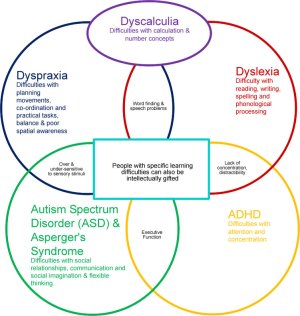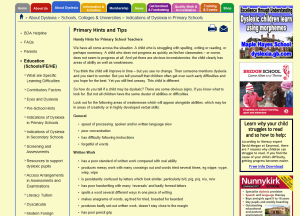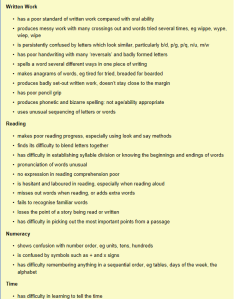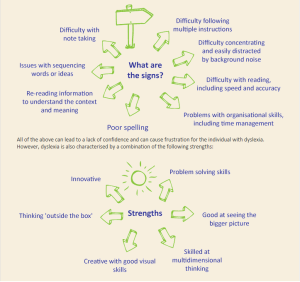Here is some background knowledge on learning difficulties and the main one that I will be focusing on in this educational resource. Learning difficulties can affect children in so many different ways and this can become evident within a classroom setting. Learning difficulties are defined as “referring to a number of disorders, which may affect the acquisition, organisation, retention, understanding or use of verbal or other information” (Lerner, 2000). So we as teachers must have different ways and methods to allow children with learning difficulties to access and engage with information in the lessons and work we provide. It is very important to make the learning achievable for these children as then they do not start to disengage with school and think negatively towards their education.
Picture courtesy of www.psychology4education.com
For this informative web page I will be focusing on Dyslexia which is a very common and prominent learning difficulty. “Dyslexia is a specific learning disability that is neurological in origin, with an estimated overall worldwide prevalence of 5–10% of the population.” (Al-Shidhani and Arora, 2012). I will provide an insight in to what Dyslexia is, how it affects children and how we as teachers can identify the signs of this. Then I will move onto discussing specific classroom situations and how we can adapt our teaching methods and delivery to include these children and make their time at school positive and engaging.
Dyslexia:
I will start by defining Dyslexia so that you can understand what it is and how it affects children in school. I found the following definition from the British Dyslexia Association (BDA), their website is a fantastic resource and provides so much valuable information which you will find useful:
“Dyslexia is best described as a specific difficulty in learning, in one or more of reading, spelling and written language which may be accompanied by difficulty in number work, short-term memory, sequencing, auditory and/or visual perception, and motor skills. It is particularly related to mastering and using written language – alphabetic, numeric and musical notation. In addition, oral language is often affected to some degree.”
(Augur, J. “n.d”)
As mentioned above the BDA is an invaluable resource and their website is extremely helpful and provides so much help to learn and understand about Dyslexia.
http://www.bdadyslexia.org.uk/
The BDA has a fantastic section in the website labelled ‘Education (Schools/HE/FE)’ click the link to be taken straight to that section of the website. You will find that it provides help and information for various topics ranging from ‘indications of Dyslexia in primary school’ to ‘Screening and assessments’ which I have linked for you. Within each of the topics there is numerous information that can help you support a child with Dyslexia. I found in particular the link ‘indications of Dyslexia in primary schools’ the most helpful in regards to helping children in KS1 and KS2. It splits the page into separate topics that occur in school, (written work, reading, numeracy, time and behaviour). It covers everything you would go through within a school day and how to provide opportunities to the child to learn and make your teaching practise inclusive.

Above are two screenshots, one showing the education section, which is the most important part for us as teachers. Then underneath I thought it would be helpful to show the layout of how the information is displayed. There is also the direct link to that section.
It is extremely important as teachers to be able to identify and notice the signs of Dyslexia and if we suspect a child of having it, what to do and how to get a child assessed. It is also imperative as teachers that we do not dwell on the negative aspects and actually focus on a lot of the positives that can come with a child being Dyslexic, as this picture below illustrates perfectly.
Picture courtesy of <www.Lexxic.com>
The video gives a brief yet detailed view of things to look out for if you suspect a child of Dyslexia from a teachers and parents stand point. Parents are just as important within this process as the school and class teacher.
Classroom Strategies:
Now I am going to show a variety of classroom strategies to help make an inclusive environment for a child with dyslexia. These strategies help cover most elements of teaching and situations that occur in the classroom. This is an invaluable resource to the teacher and all these aspects are essential if we want to make the classroom an inclusive place for children with learning difficulties.
There are numerous guides and strategies for parents and teachers alike online to help support children with dyslexia in the classroom. However, the help and guidelines provided from http://www.dyslexia.com is a relevant and helpful resource to teachers, so below there is a summary of the key points in different areas within the classroom that will affect a child with Dyslexia.
In class and copying from the board
- Have a daily checklist so the child can develop a consistent routine for each day and each school week.
- If visual memory is not great, provide hand outs and notes instead of lots of copying from the board.
- Seating the child close to the class teacher to provide easily accessible help when required.
- If copying from board, is essential to provide child enough time so that they do not rush and made to feel slow.
- If there is not much writing, then use alternate colours for different lines on the board, helps to outline the different lines of text.
Reading
- Maintain a consistent reading scheme, so the child can become familiar when reading.
- Avoid choosing Dyslexic child for spontaneous reading aloud in class, instead read 1-1 or smaller groups.
- When engaging in paired reading with an adult potential use of audio tapes is encouraged.
- Allow real books to be shared with the child, do not deny access to good material if worried they will not be able to read it.
- Most importantly reading should be made to be seen as fun and not something to worry about.
Handwriting
- Can often be due to poor motor control, adopting a cursive style of joined up handwriting helps most with Dyslexic children.
- When using spellings for Dyslexic children, it is really important that you use words that they can read and write.
- Have visual handwriting cards present for children to look as at constant example of how you want them to be writing.
Marking of work
- Praise the child when they have produced a good piece of work that meets the learning objectives, but it is important that they are giving positives for effort as well.
- Corrections on spelling mistakes should be level related to the specific child, comments should mostly be positive and done in pencil.
- Try avoiding marking their work in red ink, as it is extremely negative to receive feedback from a piece of work with red covering the majority of the page.
- Only ask children to rewrite a piece of work that you are wanting them to display in best or on a wall display. As it is not productive to make them write more than necessary.
Homework
- When setting homework, make sure that the homework you are giving them is going to be of benefit to the child’s learning and not actually just an extra stress for them.
- Make sure you set a time limit on homework, as often it will take a Dyslexic child longer to complete something in comparison to someone without.
All this information has been paraphrased and is a summary of available information from http://www.dyslexia.com/library/classroom.htm. I thought that it would be very beneficial to have some of this information displayed out on this page as a reference to teachers to help or improve their awareness if they have a child with dyslexia in their class. This is not all the information that is present on that section of the website, just a summarised piece with points of interest.
Summary
To summarise, after making this online resource, it is achievable to make a classroom inclusive for all. As long as the teacher is aware of individual children and their specific needs and capabilities, then the teachers individual strategies and classroom methods can be adjusted for those specific children. Lessons and the work that is provided for them can be differentiated so that they can access the learning, this should be done in a way so the individual does not feel singled out. With a very specific and outlined programme for children with learning difficulties, you can make their time at school a positive experience. As long as you as the teacher spend the time to integrate the specific teaching pedagogies into your teaching style you will be able to make your classroom an inclusive and positive learning environment for all children as well as any with specific learning difficulties.
Throughout this resource Dyslexia has been the main focus, but it is important to remember that this is not the only learning difficulty that children are seen to have in schools. However a lot of the information and strategies provided can be used in various situations, regardless the learning difficulty. Along with the information I have provided in the main body of the resource, below are some related articles that provide interesting insights and build upon what has been discussed. To leave on a positive note and show that a learning difficulty does not have any negative effects or that it holds a child back, here is a video showing some famous people that have dyslexia. Thank you for reading my online resource and I hope that it has been of some help to you!
Related articles
- Different Children, Different Needs (recessmag.wordpress.com)
- Identifying dyslexia in the classroom (24dash.com)
- Dyslexia – A Problem or a Gift? (oupeltglobalblog.com)
- How to teach … dyslexia awareness (theguardian.com)
References:
Al-Shidhani, T. A and Arora, V. (2012) “Understanding Dyslexia in Children through Human Development Theories”, Sultan Qaboos University Medical Journal, 12 (3), pp.286-294.
Lerner, J. W. (2000) Learning Disabilities: Theories Diagnosis and Teaching Strategies (8th edition), Boston, MA: Houghton Mifflin.
http://www.bdadyslexia.org.uk/
Augur, J. (N.D) Early Help better future: A guide to the early recognition of Dyslexia [online], British Dsylexia Association.
Available:http://www.bdadyslexia.org.uk/files/Early%20Help%20Better%20Future.pdf [Accessed November 20th].
Hodge, P. L (2000) A Dyslexic child in the classroom [online], Davis Dyslexia Association International.
Available:http://www.dyslexia.com/library/classroom.htm [Accessed 7th November 2013].


